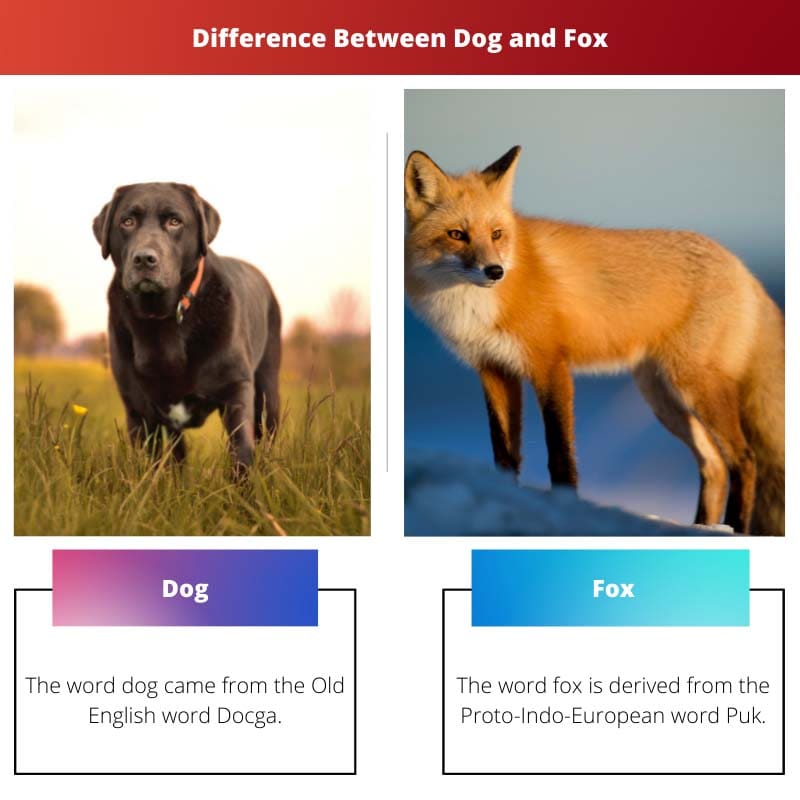Dogs and Foxes are animals. Dogs are more domesticated members of the Canis genus. Foxes are not domesticated and are from the non-canis genera.
Both of these animals share the same order, which is Carnivora. The C.Lupus species of the Candiae family are called Dogs, and Foxes are from the Vilpini tribe of the Candiae family.
Key Takeaways
- Dogs belong to the Canis lupus familiaris species, whereas foxes belong to various species within the Vulpes genus.
- Domesticated dogs exhibit diverse physical appearances and temperaments, while foxes maintain their wild characteristics and behaviors.
- Dogs serve various purposes like companionship, guarding, and assistance, whereas foxes are primarily known for their adaptability and cunningness.
Dog vs Fox
The difference between Dogs and Foxes is that they differ in their lineages. Foxes belong to the Vulpes, and Dogs to the C.lupus.Dogs and Foxes share the same kingdom, which is Animalia and the same phylum, which is Chordata. Dogs can live in our homes, and foxes live in the wild.

Dogs are derived from ancient wolves. Its nearest relative is the modern grey wolf. They adapt to humans easily and have a long association with humans.
They survive on starch-rich diets. They perform various roles to help humans. They are called “man’s best friend “. They are from the species called C.Familiaris.
In the Canidae family, foxes are smaller than the other members, such as wolves and jackals. They are digitigrade, which means they walk on their toes.
They are wild animals and cannot be domesticated. Unlike dogs which are social animals, foxes are extremely very shy. Foxes have a musky odour.
Comparison Table
| Parameters of Comparison | Dog | Fox |
|---|---|---|
| Etymology | The word dog came from the Old English word Docga. | The word fox is derived from the Proto-Indo-European word Puk. |
| Life Span | A dog can live up to 10-13 years. | A fox can live up to 2-5 years. |
| Scientific Name | A dog scientific name is Canis Lupus Familiaris | A fox scientific name is Vulpes Vulpes |
| Habitat | Dogs are adaptable in homes when they are domesticated. They live in deserts, grasslands, forests, rain forests, coastal regions and arctic zones. | They live in forests, grasslands, mountains and deserts. |
| Species | It belongs to C.Lupus | It belongs to the Vulpini tribe |
What is Dog?
The domestic dog is a descendant of the wolf. Over 15,000 years ago, the dog was domesticated by hunter-gatherers. The dogs are selectively bred based on their behaviours, such as sensory capabilities and physical attributes.
There are several dog breeds in various shapes and colours. They belong to the Canini tribe.
Dogs perform so many roles for humans and have been helpful. They help in herding, load pulling, herding, assisting the police and military, and helping in therapy and the disabled individuals.
They belong to the class of mammals. There are over 450 dog breeds that are globally recognised. The Binomial name of a dog is Canis Familiaris.
A dog’s senses incorporate the ability to see, hear, smell, taste, touch and sensitivity to the earth’s magnetic field. Their sexual maturity begins from one year to six months in both female and male dogs. They have advanced memory skills and can associate verbal commands of over 1,000 words.
Dogs’ communication behaviour is through their eye gaze, facial expressions, body posture, vocalization and gustatory communication. They are omnivorous.
According to a survey report, there are over nine hundred million dogs globally, seventeen to twenty-four per cent of which dogs are raised as pets.

What is Fox?
Foxes are medium to small-sized animals. They are omnivorous. They belong to the class of mammals. They live on every continent except Antarctica.
Foxes have a flattened skull, upright triangle ears, upturned snout and bushy tails. They are from the Canidae family. Their order is Carnivora, and the suborder is Caniformia.
The name Fox is derived from the Proto-Indo-European word pun, which means thick-haired tail.
Foxes differ in their fur colour, length and density. According to the change in seasons, foxes, coat colour and texture may vary in the colder months; fox pelts are richer and denser; they are lighter in the warmer months.
To help them navigate, foxes have whiskers on their legs and face. A male fox is called a dog fox, and a female fox is called Vixen. A Gray fox can run up to 68 kilometres per hour. They are cunning animals. The red fox is especially hunted for its pelt, which is a mainstay when it comes to the fur trade.
In many folklore, foxes are utilised as a symbol of cunningness and trickery. Foxes can evade hunters. In Asian folklore, foxes are the same as familiar spirits who possess magical powers. In Western folklore, foxes are portrayed to be mischievous.

Main Differences Between Dog and Fox
- Over twelve thousand years, dogs have given companionship to humans and are domestic animals. Foxes are wild animals.
- Dogs belong to the two main subspecies and have now evolved up to four hundred and fifty breeds. Foxes have about twelve species. Dogs are friendly towards humans, while foxes stay away from humans.
- The foxes are smaller in height when compared to dogs, and they weigh between five to six kilograms. Dogs are heavier in size than foxes.
- Dogs are domesticated, and even in the wild, they live in large packs and also hunt in packs. Whereas foxes live alone and hunt small animals such as rats, rabbits etc.
- Dogs are adaptable to various environments when they are domesticated. They can live in homes if they are domesticated. They live in deserts, grasslands, forests, rainforests, coastal regions and arctic zones. Foxes live in forests, grasslands, mountains and deserts.
- Foxes have a lifespan of about two to four years, but dogs can live for about twelve to thirteen years. Foxes are very difficult to train. Dogs obey the commands, but foxes do not. Foxes cannot be relied upon and cannot be house-trained. Dogs can be relied on and can be house-trained.

- https://www.sciencedirect.com/science/article/pii/S088875439995989X
- https://www.cambridge.org/core/journals/parasitology/article/role-of-dog-behaviour-and-environmental-fecal-contamination-in-transmission-of-echinococcus-multilocularis-in-tibetan-communities/5E8F8232DE2C775BB7339BB510823276

The detailed explanations of dogs and foxes, including their respective backgrounds, behaviors, and sensory capabilities, offer a comprehensive understanding of these animals.
You’ve concisely highlighted the various roles played by dogs and the unique features of foxes, contributing to a nuanced comparison between the two species.
I appreciate the comparison between dogs and foxes, including details on their etymology, life span, scientific names, and habitats. It’s helpful to understand the classifications of these creatures.
Your comment provides an insightful overview of key parameters for comparing dogs and foxes, adding depth to the article’s content.
The detailed information you shared about the habitats and scientific classification of dogs and foxes enhances the understanding of their distinct characteristics.
It’s fascinating to learn that dogs were domesticated from ancient wolves, while foxes are smaller members of the Canidae family. The comparison table you provided sheds light on specific differences between the two animals.
The details on the life spans and scientific names of dogs and foxes offer valuable scientific insights into these animals.
Your comment effectively captures the evolutionary backgrounds of dogs and foxes, highlighting their unique traits and characteristics.
The global distribution of dogs and the distinct behavioral patterns and habitats of foxes underscore the diverse adaptation and ecological roles of these animals across different environments.
Your comment effectively highlights the global distribution of dogs and the ecological significance of foxes, offering a nuanced understanding of their adaptability.
Your insightful comment about the distinct behavioral patterns and habitats of dogs and foxes provides valuable context for understanding their ecological roles and niche diversity.
Dogs and Foxes are both animals from the Carnivora order with distinct species. While dogs are domesticated and belong to the Canis lupus familiaris species, foxes are canid but are not domesticated and belong to the Vulpes genus.
You have summarized the article well, providing the key takeaways for readers to understand the difference between dogs and foxes.
The comparison between dogs and foxes, including the evolutionary lineage and sensory capabilities of dogs and the distinct physical features and navigational skills of foxes, presents a detailed analysis of these animals.
Your precise analysis of the evolutionary lineage and sensory capabilities of dogs, combined with the distinct features and navigational skills of foxes, offers valuable insights into the diverse characteristics and adaptations of these species.
Despite sharing the same kingdom and phylum, dogs are domesticated animals that can live in homes, while foxes are wild and primarily live in forests, grasslands, and mountains.
The distinction in habitats and domestication is clear from your comment. It helps in understanding the different lifestyles of both animals.
The thorough description of dogs and foxes, from their evolutionary origins to their physical characteristics and communication behaviors, presents an insightful contrast between these animals.
Your comment effectively outlines the differences in the evolution and behaviors of dogs and foxes, providing valuable information for readers.
Your accurate description of the sensory capabilities and communication behaviors of dogs enriches the discussion about the unique attributes of these animals.
The comprehensive overview of dog breeds, their roles in human activities, and their sensory capabilities enhances the understanding of the significance of dogs in various contexts.
Your detailed description of dog breeds and their roles in human activities enriches the content by capturing the multidimensional nature of dogs’ contributions to human society.
The details on the physical features, behaviors, and hunting techniques of foxes, as well as the symbolism attributed to foxes, add depth to the comparison between dogs and foxes.
Your insightful comment about the cunning nature of foxes and their significance in folklore contributes to the broader context of this comparative discussion.
Your comprehensive comment delves into the physiological attributes and symbolism associated with foxes, providing a well-rounded understanding of these animals.